CAT Exam > CAT Questions > 10 people are sitting around a circular table...
Start Learning for Free
10 people are sitting around a circular table, each facing the table. They are numbered 1 to 10 and are sitting in the following manner.
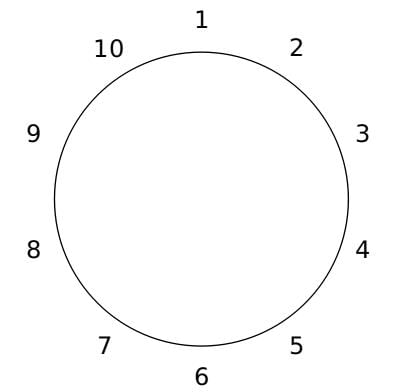
They sit in the same arrangement for some time, till there is a transition. In a transition, one person moves out of the table, and a different person moves in, although not in the same seat. It happens in the following manner. In the first transition, a particular person(say A) moves out of the table, the person sitting diametrically opposite to A(say B) replaces him(A), and a new person(say C) enters the position where B sat initially. Every new person coming into the table is numbered in a successive way. So, the first person joining the table when one person leaves will be numbered 11, the next person joining the table will be numbered 12 and so on. In the second transition, the person to the immediate right of the person who joined last(say X), moves away. The person diametrically opposite to him(say Y) replaces him, and a new person(say Z) replaces Y. And this goes on. For example, suppose, in the first transition, 1 moves out of the table and 6 replaces him. A new person numbered 11 enters the position where 6 sat initially. In the second transition, the person to the immediate right of 11, that is 5, moves out of the table and 10 replaces him, and a new person 12 enters the position where 10 sat initially and it continues.
Based on the above information, answer the questions that follow.

They sit in the same arrangement for some time, till there is a transition. In a transition, one person moves out of the table, and a different person moves in, although not in the same seat. It happens in the following manner. In the first transition, a particular person(say A) moves out of the table, the person sitting diametrically opposite to A(say B) replaces him(A), and a new person(say C) enters the position where B sat initially. Every new person coming into the table is numbered in a successive way. So, the first person joining the table when one person leaves will be numbered 11, the next person joining the table will be numbered 12 and so on. In the second transition, the person to the immediate right of the person who joined last(say X), moves away. The person diametrically opposite to him(say Y) replaces him, and a new person(say Z) replaces Y. And this goes on. For example, suppose, in the first transition, 1 moves out of the table and 6 replaces him. A new person numbered 11 enters the position where 6 sat initially. In the second transition, the person to the immediate right of 11, that is 5, moves out of the table and 10 replaces him, and a new person 12 enters the position where 10 sat initially and it continues.
Based on the above information, answer the questions that follow.
Q. The person numbered 4 moves out of the table in the first transition. Let Xn be the initial position of the person numbered n, and let Ym be the position of the person numbered m after the 5th transition. Which of the following pairs represent the same position?
- a)X4, Y1
- b)X7, Y3
- c)X9, Y5
- d)X2, Y7
Correct answer is option 'D'. Can you explain this answer?
Most Upvoted Answer
10 people are sitting around a circular table, each facing the table. ...
Initially, the arrangement is as follows.
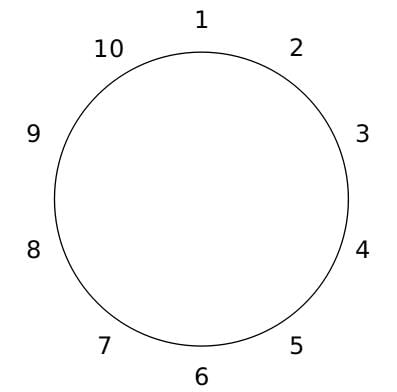
Now, in the first transition, 1 moves out, 6 replaces 1 and 11 replaces 6.
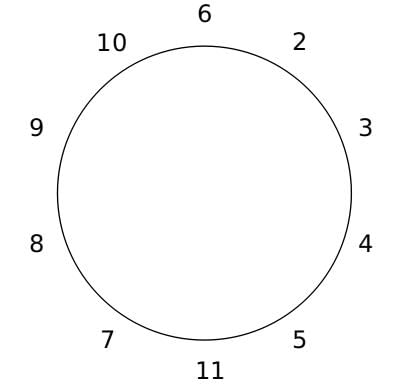
Now in the second transition, 5 moves out, 10 replaces 5, and 12 replaces 10.
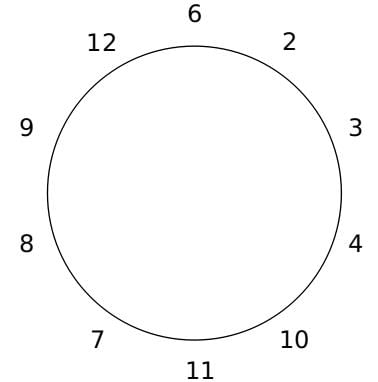
Now, in the third transition, 9 moves out, 4 replaces 9, and 13 replaces 4.
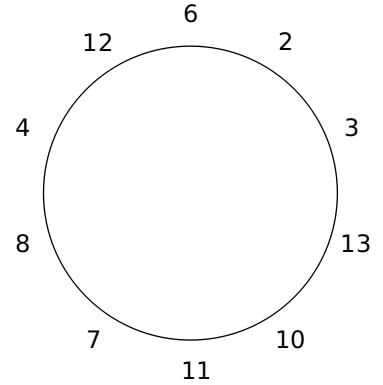
In the fourth transition, 3 moves out, 8 replaces 3, and 14 replaces 8.

In the fifth transition, 7 moves out, 2 replaces 7 and 15 replaces 2.
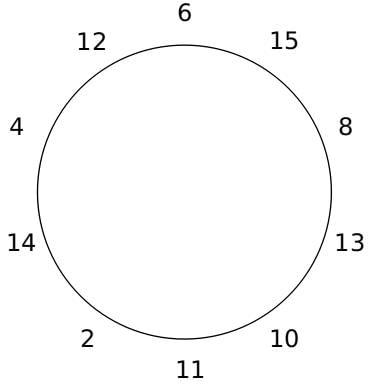

But in this question, we have been given that 4 moves out in the first transition.
Now we can take 2 approaches. First, we can repeat what we did when 1 moved out in the first transition to the case when 4 moved out in the first transition, and follow similar steps to find out who sits where after the fifth transition.
The second and better approach is that since we have already worked out who sits where after the fifth transition (when 1 moves out first), we can simply apply the final results, adjusting them in a way that 4 is the first one to move. This approach follows the logic that irrespective of the person, the one who is sitting on A moves out first, so we can adjust in a way that 4 sits on A in the initial arrangement.

Now, in the first table, we see that 6 who was sitting on F is replacing 1, who was sitting on A. SImilarly, in table 2, 9 who is sitting on F will replace 4 who is sitting on A.
In the first table, 15(the person joining in the fifth transition) is replacing the one sitting at B. Similarly in table 2, 15 will be replacing 5.
In the first table, we see that 8 who was sitting on H is replacing 3, who was sitting on C. SImilarly, in table 2, 1 who is sitting on H will replace 6 who is sitting on C.
In the first table, 13(the person joining in th 3rd transition) is replacing the one sitting on D. Similarly in table 2, 13 will be replacing 7.
We can continue in a similar fashion to find out the positions of all people after the 5th transition.

Hence the initial position of 2 and the final position of 7 are the same.

Now, in the first transition, 1 moves out, 6 replaces 1 and 11 replaces 6.

Now in the second transition, 5 moves out, 10 replaces 5, and 12 replaces 10.

Now, in the third transition, 9 moves out, 4 replaces 9, and 13 replaces 4.

In the fourth transition, 3 moves out, 8 replaces 3, and 14 replaces 8.

In the fifth transition, 7 moves out, 2 replaces 7 and 15 replaces 2.


But in this question, we have been given that 4 moves out in the first transition.
Now we can take 2 approaches. First, we can repeat what we did when 1 moved out in the first transition to the case when 4 moved out in the first transition, and follow similar steps to find out who sits where after the fifth transition.
The second and better approach is that since we have already worked out who sits where after the fifth transition (when 1 moves out first), we can simply apply the final results, adjusting them in a way that 4 is the first one to move. This approach follows the logic that irrespective of the person, the one who is sitting on A moves out first, so we can adjust in a way that 4 sits on A in the initial arrangement.

Now, in the first table, we see that 6 who was sitting on F is replacing 1, who was sitting on A. SImilarly, in table 2, 9 who is sitting on F will replace 4 who is sitting on A.
In the first table, 15(the person joining in the fifth transition) is replacing the one sitting at B. Similarly in table 2, 15 will be replacing 5.
In the first table, we see that 8 who was sitting on H is replacing 3, who was sitting on C. SImilarly, in table 2, 1 who is sitting on H will replace 6 who is sitting on C.
In the first table, 13(the person joining in th 3rd transition) is replacing the one sitting on D. Similarly in table 2, 13 will be replacing 7.
We can continue in a similar fashion to find out the positions of all people after the 5th transition.

Hence the initial position of 2 and the final position of 7 are the same.

|
Explore Courses for CAT exam
|

|
Similar CAT Doubts
10 people are sitting around a circular table, each facing the table. They are numbered 1 to 10 and are sitting in the following manner.They sit in the same arrangement for some time, till there is a transition. In a transition, one person moves out of the table, and a different person moves in, although not in the same seat. It happens in the following manner. In the first transition, a particular person(say A) moves out of the table, the person sitting diametrically opposite to A(say B) replaces him(A), and a new person(say C) enters the position where B sat initially. Every new person coming into the table is numbered in a successive way. So, the first person joining the table when one person leaves will be numbered 11, the next person joining the table will be numbered 12 and so on. In the second transition, the person to the immediate right of the person who joined last(say X), moves away. The person diametrically opposite to him(say Y) replaces him, and a new person(say Z) replaces Y. And this goes on. For example, suppose, in the first transition, 1 moves out of the table and 6 replaces him. A new person numbered 11 enters the position where 6 sat initially. In the second transition, the person to the immediate right of 11, that is 5, moves out of the table and 10 replaces him, and a new person 12 enters the position where 10 sat initially and it continues.Based on the above information, answer the questions that follow.Q.The person numbered 4 moves out of the table in the first transition. Let Xnbe the initial position of the person numbered n, and let Ymbe the position of the person numbered m after the 5th transition. Which of the following pairs represent the same position?a)X4, Y1b)X7, Y3c)X9, Y5d)X2, Y7Correct answer is option 'D'. Can you explain this answer?
Question Description
10 people are sitting around a circular table, each facing the table. They are numbered 1 to 10 and are sitting in the following manner.They sit in the same arrangement for some time, till there is a transition. In a transition, one person moves out of the table, and a different person moves in, although not in the same seat. It happens in the following manner. In the first transition, a particular person(say A) moves out of the table, the person sitting diametrically opposite to A(say B) replaces him(A), and a new person(say C) enters the position where B sat initially. Every new person coming into the table is numbered in a successive way. So, the first person joining the table when one person leaves will be numbered 11, the next person joining the table will be numbered 12 and so on. In the second transition, the person to the immediate right of the person who joined last(say X), moves away. The person diametrically opposite to him(say Y) replaces him, and a new person(say Z) replaces Y. And this goes on. For example, suppose, in the first transition, 1 moves out of the table and 6 replaces him. A new person numbered 11 enters the position where 6 sat initially. In the second transition, the person to the immediate right of 11, that is 5, moves out of the table and 10 replaces him, and a new person 12 enters the position where 10 sat initially and it continues.Based on the above information, answer the questions that follow.Q.The person numbered 4 moves out of the table in the first transition. Let Xnbe the initial position of the person numbered n, and let Ymbe the position of the person numbered m after the 5th transition. Which of the following pairs represent the same position?a)X4, Y1b)X7, Y3c)X9, Y5d)X2, Y7Correct answer is option 'D'. Can you explain this answer? for CAT 2025 is part of CAT preparation. The Question and answers have been prepared according to the CAT exam syllabus. Information about 10 people are sitting around a circular table, each facing the table. They are numbered 1 to 10 and are sitting in the following manner.They sit in the same arrangement for some time, till there is a transition. In a transition, one person moves out of the table, and a different person moves in, although not in the same seat. It happens in the following manner. In the first transition, a particular person(say A) moves out of the table, the person sitting diametrically opposite to A(say B) replaces him(A), and a new person(say C) enters the position where B sat initially. Every new person coming into the table is numbered in a successive way. So, the first person joining the table when one person leaves will be numbered 11, the next person joining the table will be numbered 12 and so on. In the second transition, the person to the immediate right of the person who joined last(say X), moves away. The person diametrically opposite to him(say Y) replaces him, and a new person(say Z) replaces Y. And this goes on. For example, suppose, in the first transition, 1 moves out of the table and 6 replaces him. A new person numbered 11 enters the position where 6 sat initially. In the second transition, the person to the immediate right of 11, that is 5, moves out of the table and 10 replaces him, and a new person 12 enters the position where 10 sat initially and it continues.Based on the above information, answer the questions that follow.Q.The person numbered 4 moves out of the table in the first transition. Let Xnbe the initial position of the person numbered n, and let Ymbe the position of the person numbered m after the 5th transition. Which of the following pairs represent the same position?a)X4, Y1b)X7, Y3c)X9, Y5d)X2, Y7Correct answer is option 'D'. Can you explain this answer? covers all topics & solutions for CAT 2025 Exam. Find important definitions, questions, meanings, examples, exercises and tests below for 10 people are sitting around a circular table, each facing the table. They are numbered 1 to 10 and are sitting in the following manner.They sit in the same arrangement for some time, till there is a transition. In a transition, one person moves out of the table, and a different person moves in, although not in the same seat. It happens in the following manner. In the first transition, a particular person(say A) moves out of the table, the person sitting diametrically opposite to A(say B) replaces him(A), and a new person(say C) enters the position where B sat initially. Every new person coming into the table is numbered in a successive way. So, the first person joining the table when one person leaves will be numbered 11, the next person joining the table will be numbered 12 and so on. In the second transition, the person to the immediate right of the person who joined last(say X), moves away. The person diametrically opposite to him(say Y) replaces him, and a new person(say Z) replaces Y. And this goes on. For example, suppose, in the first transition, 1 moves out of the table and 6 replaces him. A new person numbered 11 enters the position where 6 sat initially. In the second transition, the person to the immediate right of 11, that is 5, moves out of the table and 10 replaces him, and a new person 12 enters the position where 10 sat initially and it continues.Based on the above information, answer the questions that follow.Q.The person numbered 4 moves out of the table in the first transition. Let Xnbe the initial position of the person numbered n, and let Ymbe the position of the person numbered m after the 5th transition. Which of the following pairs represent the same position?a)X4, Y1b)X7, Y3c)X9, Y5d)X2, Y7Correct answer is option 'D'. Can you explain this answer?.
10 people are sitting around a circular table, each facing the table. They are numbered 1 to 10 and are sitting in the following manner.They sit in the same arrangement for some time, till there is a transition. In a transition, one person moves out of the table, and a different person moves in, although not in the same seat. It happens in the following manner. In the first transition, a particular person(say A) moves out of the table, the person sitting diametrically opposite to A(say B) replaces him(A), and a new person(say C) enters the position where B sat initially. Every new person coming into the table is numbered in a successive way. So, the first person joining the table when one person leaves will be numbered 11, the next person joining the table will be numbered 12 and so on. In the second transition, the person to the immediate right of the person who joined last(say X), moves away. The person diametrically opposite to him(say Y) replaces him, and a new person(say Z) replaces Y. And this goes on. For example, suppose, in the first transition, 1 moves out of the table and 6 replaces him. A new person numbered 11 enters the position where 6 sat initially. In the second transition, the person to the immediate right of 11, that is 5, moves out of the table and 10 replaces him, and a new person 12 enters the position where 10 sat initially and it continues.Based on the above information, answer the questions that follow.Q.The person numbered 4 moves out of the table in the first transition. Let Xnbe the initial position of the person numbered n, and let Ymbe the position of the person numbered m after the 5th transition. Which of the following pairs represent the same position?a)X4, Y1b)X7, Y3c)X9, Y5d)X2, Y7Correct answer is option 'D'. Can you explain this answer? for CAT 2025 is part of CAT preparation. The Question and answers have been prepared according to the CAT exam syllabus. Information about 10 people are sitting around a circular table, each facing the table. They are numbered 1 to 10 and are sitting in the following manner.They sit in the same arrangement for some time, till there is a transition. In a transition, one person moves out of the table, and a different person moves in, although not in the same seat. It happens in the following manner. In the first transition, a particular person(say A) moves out of the table, the person sitting diametrically opposite to A(say B) replaces him(A), and a new person(say C) enters the position where B sat initially. Every new person coming into the table is numbered in a successive way. So, the first person joining the table when one person leaves will be numbered 11, the next person joining the table will be numbered 12 and so on. In the second transition, the person to the immediate right of the person who joined last(say X), moves away. The person diametrically opposite to him(say Y) replaces him, and a new person(say Z) replaces Y. And this goes on. For example, suppose, in the first transition, 1 moves out of the table and 6 replaces him. A new person numbered 11 enters the position where 6 sat initially. In the second transition, the person to the immediate right of 11, that is 5, moves out of the table and 10 replaces him, and a new person 12 enters the position where 10 sat initially and it continues.Based on the above information, answer the questions that follow.Q.The person numbered 4 moves out of the table in the first transition. Let Xnbe the initial position of the person numbered n, and let Ymbe the position of the person numbered m after the 5th transition. Which of the following pairs represent the same position?a)X4, Y1b)X7, Y3c)X9, Y5d)X2, Y7Correct answer is option 'D'. Can you explain this answer? covers all topics & solutions for CAT 2025 Exam. Find important definitions, questions, meanings, examples, exercises and tests below for 10 people are sitting around a circular table, each facing the table. They are numbered 1 to 10 and are sitting in the following manner.They sit in the same arrangement for some time, till there is a transition. In a transition, one person moves out of the table, and a different person moves in, although not in the same seat. It happens in the following manner. In the first transition, a particular person(say A) moves out of the table, the person sitting diametrically opposite to A(say B) replaces him(A), and a new person(say C) enters the position where B sat initially. Every new person coming into the table is numbered in a successive way. So, the first person joining the table when one person leaves will be numbered 11, the next person joining the table will be numbered 12 and so on. In the second transition, the person to the immediate right of the person who joined last(say X), moves away. The person diametrically opposite to him(say Y) replaces him, and a new person(say Z) replaces Y. And this goes on. For example, suppose, in the first transition, 1 moves out of the table and 6 replaces him. A new person numbered 11 enters the position where 6 sat initially. In the second transition, the person to the immediate right of 11, that is 5, moves out of the table and 10 replaces him, and a new person 12 enters the position where 10 sat initially and it continues.Based on the above information, answer the questions that follow.Q.The person numbered 4 moves out of the table in the first transition. Let Xnbe the initial position of the person numbered n, and let Ymbe the position of the person numbered m after the 5th transition. Which of the following pairs represent the same position?a)X4, Y1b)X7, Y3c)X9, Y5d)X2, Y7Correct answer is option 'D'. Can you explain this answer?.
Solutions for 10 people are sitting around a circular table, each facing the table. They are numbered 1 to 10 and are sitting in the following manner.They sit in the same arrangement for some time, till there is a transition. In a transition, one person moves out of the table, and a different person moves in, although not in the same seat. It happens in the following manner. In the first transition, a particular person(say A) moves out of the table, the person sitting diametrically opposite to A(say B) replaces him(A), and a new person(say C) enters the position where B sat initially. Every new person coming into the table is numbered in a successive way. So, the first person joining the table when one person leaves will be numbered 11, the next person joining the table will be numbered 12 and so on. In the second transition, the person to the immediate right of the person who joined last(say X), moves away. The person diametrically opposite to him(say Y) replaces him, and a new person(say Z) replaces Y. And this goes on. For example, suppose, in the first transition, 1 moves out of the table and 6 replaces him. A new person numbered 11 enters the position where 6 sat initially. In the second transition, the person to the immediate right of 11, that is 5, moves out of the table and 10 replaces him, and a new person 12 enters the position where 10 sat initially and it continues.Based on the above information, answer the questions that follow.Q.The person numbered 4 moves out of the table in the first transition. Let Xnbe the initial position of the person numbered n, and let Ymbe the position of the person numbered m after the 5th transition. Which of the following pairs represent the same position?a)X4, Y1b)X7, Y3c)X9, Y5d)X2, Y7Correct answer is option 'D'. Can you explain this answer? in English & in Hindi are available as part of our courses for CAT.
Download more important topics, notes, lectures and mock test series for CAT Exam by signing up for free.
Here you can find the meaning of 10 people are sitting around a circular table, each facing the table. They are numbered 1 to 10 and are sitting in the following manner.They sit in the same arrangement for some time, till there is a transition. In a transition, one person moves out of the table, and a different person moves in, although not in the same seat. It happens in the following manner. In the first transition, a particular person(say A) moves out of the table, the person sitting diametrically opposite to A(say B) replaces him(A), and a new person(say C) enters the position where B sat initially. Every new person coming into the table is numbered in a successive way. So, the first person joining the table when one person leaves will be numbered 11, the next person joining the table will be numbered 12 and so on. In the second transition, the person to the immediate right of the person who joined last(say X), moves away. The person diametrically opposite to him(say Y) replaces him, and a new person(say Z) replaces Y. And this goes on. For example, suppose, in the first transition, 1 moves out of the table and 6 replaces him. A new person numbered 11 enters the position where 6 sat initially. In the second transition, the person to the immediate right of 11, that is 5, moves out of the table and 10 replaces him, and a new person 12 enters the position where 10 sat initially and it continues.Based on the above information, answer the questions that follow.Q.The person numbered 4 moves out of the table in the first transition. Let Xnbe the initial position of the person numbered n, and let Ymbe the position of the person numbered m after the 5th transition. Which of the following pairs represent the same position?a)X4, Y1b)X7, Y3c)X9, Y5d)X2, Y7Correct answer is option 'D'. Can you explain this answer? defined & explained in the simplest way possible. Besides giving the explanation of
10 people are sitting around a circular table, each facing the table. They are numbered 1 to 10 and are sitting in the following manner.They sit in the same arrangement for some time, till there is a transition. In a transition, one person moves out of the table, and a different person moves in, although not in the same seat. It happens in the following manner. In the first transition, a particular person(say A) moves out of the table, the person sitting diametrically opposite to A(say B) replaces him(A), and a new person(say C) enters the position where B sat initially. Every new person coming into the table is numbered in a successive way. So, the first person joining the table when one person leaves will be numbered 11, the next person joining the table will be numbered 12 and so on. In the second transition, the person to the immediate right of the person who joined last(say X), moves away. The person diametrically opposite to him(say Y) replaces him, and a new person(say Z) replaces Y. And this goes on. For example, suppose, in the first transition, 1 moves out of the table and 6 replaces him. A new person numbered 11 enters the position where 6 sat initially. In the second transition, the person to the immediate right of 11, that is 5, moves out of the table and 10 replaces him, and a new person 12 enters the position where 10 sat initially and it continues.Based on the above information, answer the questions that follow.Q.The person numbered 4 moves out of the table in the first transition. Let Xnbe the initial position of the person numbered n, and let Ymbe the position of the person numbered m after the 5th transition. Which of the following pairs represent the same position?a)X4, Y1b)X7, Y3c)X9, Y5d)X2, Y7Correct answer is option 'D'. Can you explain this answer?, a detailed solution for 10 people are sitting around a circular table, each facing the table. They are numbered 1 to 10 and are sitting in the following manner.They sit in the same arrangement for some time, till there is a transition. In a transition, one person moves out of the table, and a different person moves in, although not in the same seat. It happens in the following manner. In the first transition, a particular person(say A) moves out of the table, the person sitting diametrically opposite to A(say B) replaces him(A), and a new person(say C) enters the position where B sat initially. Every new person coming into the table is numbered in a successive way. So, the first person joining the table when one person leaves will be numbered 11, the next person joining the table will be numbered 12 and so on. In the second transition, the person to the immediate right of the person who joined last(say X), moves away. The person diametrically opposite to him(say Y) replaces him, and a new person(say Z) replaces Y. And this goes on. For example, suppose, in the first transition, 1 moves out of the table and 6 replaces him. A new person numbered 11 enters the position where 6 sat initially. In the second transition, the person to the immediate right of 11, that is 5, moves out of the table and 10 replaces him, and a new person 12 enters the position where 10 sat initially and it continues.Based on the above information, answer the questions that follow.Q.The person numbered 4 moves out of the table in the first transition. Let Xnbe the initial position of the person numbered n, and let Ymbe the position of the person numbered m after the 5th transition. Which of the following pairs represent the same position?a)X4, Y1b)X7, Y3c)X9, Y5d)X2, Y7Correct answer is option 'D'. Can you explain this answer? has been provided alongside types of 10 people are sitting around a circular table, each facing the table. They are numbered 1 to 10 and are sitting in the following manner.They sit in the same arrangement for some time, till there is a transition. In a transition, one person moves out of the table, and a different person moves in, although not in the same seat. It happens in the following manner. In the first transition, a particular person(say A) moves out of the table, the person sitting diametrically opposite to A(say B) replaces him(A), and a new person(say C) enters the position where B sat initially. Every new person coming into the table is numbered in a successive way. So, the first person joining the table when one person leaves will be numbered 11, the next person joining the table will be numbered 12 and so on. In the second transition, the person to the immediate right of the person who joined last(say X), moves away. The person diametrically opposite to him(say Y) replaces him, and a new person(say Z) replaces Y. And this goes on. For example, suppose, in the first transition, 1 moves out of the table and 6 replaces him. A new person numbered 11 enters the position where 6 sat initially. In the second transition, the person to the immediate right of 11, that is 5, moves out of the table and 10 replaces him, and a new person 12 enters the position where 10 sat initially and it continues.Based on the above information, answer the questions that follow.Q.The person numbered 4 moves out of the table in the first transition. Let Xnbe the initial position of the person numbered n, and let Ymbe the position of the person numbered m after the 5th transition. Which of the following pairs represent the same position?a)X4, Y1b)X7, Y3c)X9, Y5d)X2, Y7Correct answer is option 'D'. Can you explain this answer? theory, EduRev gives you an
ample number of questions to practice 10 people are sitting around a circular table, each facing the table. They are numbered 1 to 10 and are sitting in the following manner.They sit in the same arrangement for some time, till there is a transition. In a transition, one person moves out of the table, and a different person moves in, although not in the same seat. It happens in the following manner. In the first transition, a particular person(say A) moves out of the table, the person sitting diametrically opposite to A(say B) replaces him(A), and a new person(say C) enters the position where B sat initially. Every new person coming into the table is numbered in a successive way. So, the first person joining the table when one person leaves will be numbered 11, the next person joining the table will be numbered 12 and so on. In the second transition, the person to the immediate right of the person who joined last(say X), moves away. The person diametrically opposite to him(say Y) replaces him, and a new person(say Z) replaces Y. And this goes on. For example, suppose, in the first transition, 1 moves out of the table and 6 replaces him. A new person numbered 11 enters the position where 6 sat initially. In the second transition, the person to the immediate right of 11, that is 5, moves out of the table and 10 replaces him, and a new person 12 enters the position where 10 sat initially and it continues.Based on the above information, answer the questions that follow.Q.The person numbered 4 moves out of the table in the first transition. Let Xnbe the initial position of the person numbered n, and let Ymbe the position of the person numbered m after the 5th transition. Which of the following pairs represent the same position?a)X4, Y1b)X7, Y3c)X9, Y5d)X2, Y7Correct answer is option 'D'. Can you explain this answer? tests, examples and also practice CAT tests.

|
Explore Courses for CAT exam
|

|
Signup for Free!
Signup to see your scores go up within 7 days! Learn & Practice with 1000+ FREE Notes, Videos & Tests.
























